Міжнародна науково-практична конференція «Україноспів: від традиції до сучасності»

Presentation by Yuri Bilinsky at the International Academic and Practical Conference ''Ukrainian Song: From Tradition to Modernity'' February 4–6, 2025
What makes our program unique is that we motivate children to reproduce dialects and traditional singing with complete precision. It’s not just about Ukrainian children reinterpreting folk songs or mimicking folklore — it’s about trying to sing and speak exactly the way their grandmothers and grandfathers once did. The children begin by listening to original archival recordings and work to replicate them as faithfully as possible, down to the smallest detail.
Where did this idea come from? Ever since childhood, I’ve asked myself: Why does the language I hear on Ukrainian television — even in the great Ukrainian poetic films — differ so drastically from the speech I heard in Ukrainian villages in the 1970s and 80s? I saw how the richness of the authentic language was virtually absent from public discourse, surviving only in folkloric programs featuring ordinary villagers. And today, the language of our mainstream media sounds even further removed from those roots.
Even the songs performed by many current folk ensembles — both adult and children’s — sound noticeably different from how they did 30 or 40 years ago. I realized this back in the early 1990s, when I first heard new urban-based folk groups and enthusiasts. As Nina Reva of the Drevo ensemble once told me, “Singing sounds very different when someone learns it as an adult, especially outside the place where it originally came from, compared to when it’s passed down from a parent in the village.”
In other words, the vibrant language that once flourished in Ukrainian villages — and that people my age still remember — may disappear with the older generation, even while the Ukrainian language is officially dominant in the country. Our program has shown that even elderly people, when surrounded by younger generations, begin to lose their pronunciation and vocabulary. And older voices carry a different tonal quality anyway. I realized that I had never truly heard what many Ukrainian dialects sound like when spoken by children. Isn’t that a tragedy?
This realization haunted me for years. I understood that if we didn’t draw our children’s attention to this issue now, no one would do it for us. The problem, although obvious to some, hadn’t been fully acknowledged at the societal level.
So a major question emerged: Can we teach children to speak and sing the way their grandparents did when they were young? And the ultimate goal — the maximum task — is to root these linguistic and cultural practices in the younger generation so they can be passed on to the future.
That’s why our approach involves having children listen to original recordings or live conversations and performances by speakers of pure dialects — and replicate everything with full accuracy: pronunciation, vocabulary, sentence structure, intonation. In our program, this is done under the guidance of experienced folklorists who can teach them the authentic sound.
And I’m thrilled to share that now, at the end of our program’s fourth year, we’ve achieved that natural sound of many Ukrainian dialects and singing traditions — replicated by more than a hundred of our participants. We have seven regional centers. In some cases, it took as many as 20 sessions; in others, much less. But we got there: the children now sound like their grandparents did 60 or 70 years ago. This is our gift to Ukraine.
And now, let’s think together about how to carry these treasures into the future.
Виступ Юрія Білінського на Міжнародній науково-практичній конференції «Україноспів: від традиції до сучасності» 4-6 лютого 2025 року
Особливість нашої програми в тому, що ми мотивуємо дітей відтворювати говірки і пісенну традицію в повній точності. Не просто переспівувати пісні, фольклор, а намагатися зробити це так, як це колись робили їхні бабусі і дідусі. Діти насамперед слухають оригінальні записи і намагаються відтворювати їх, але відтворювати у повній точності.
Як ця ідея народилась? У мене ще з дитинства одне з головних питань було, чому мова, наприклад, українського телебачення чи навіть мова українського поетичного кіно дуже сильно відрізняється від того, що я чув на вулицях українських сіл у 70-80-ті роки. Я бачив, як багатство народної мови фактично не представлене ніде, крім фольклорних передач у виконанні простих людей. А що говорити про нашу нинішню мову телебачення і радіо.
Навіть пісні у виконанні багатьох фольклорних колективів, дорослих чи дитячих, зараз звучать зовсім інакше, ніж 30-40 років тому. Я це відчув ще на початку 90-х, коли почув, як співають нові фольклорні колективи і фольклорні ентузіасти, які почали з’являтись в містах. Як мені колись сказала Ніна Рева з ансамбля Древо – «Спів звучить зовсім інакше, коли людина вчиться співати в дорослому віці, та ще й десь в іншому місці, ніж коли спів передався від батька у селі».
Тобто, можна говорити про те, що та мова, яка буяла в українських селах і яку люди мого віку ми ще пам’ятають, може померти разом із старшим поколінням, навіть за номінального панування української мови в Україні. Як ми побачили в нашій програмі, навіть старі люди, попавши у середовище молодших, втрачають свою вимову і лексику. Крім того, у старих людей мова взагалі звучить інакше. І я зрозумів, що ніколи не чув, як українські діалекти по-справжньому звучать в устах дітей. Чи це не трагедія?
Ця трагедія довго не давала мені спати ночами. Я зрозумів, що якщо ми зараз не привернемо увагу наших дітей до цього, ніхто за нас це не зробить, бо на рівні суспільства ця проблема, хоч і була досить очевидною, не була усвідомлена.
І постало дуже важливе питання – спробувати навчити дітей говорити і співати так, як говорили і співали їхні бабусі і дідусі в молодому віці. Ну і завдання-максимум – щоб ці мовні і культурні практики вкоренились в молодшому поколінні і таким чином передались у майбутнє.
Тому наш підхід полягає в тому, щоб діти слухали оригінальні записи чи живу розмову/виконання носієм чистої говірки і повторювали все у повній точності, з точною вимовою, лексикою, побудовою речень, інтонаціями. У нашій програмі це відбувається під керівництвом досвідчених фольклористів, які можуть навчити того природного звуку.
І я хочу поділитись радістю, що наприкінці четвертого року нашої програми ми досягли того природного звуку багатьох українських говірок і пісенних традицій у більше сотні наших вихованців. У нас сім регіональних центрів. У деяких з них це зайняло до 20 занять, у деяких це було набагато легше. Але ми досягли того, що діти звучать, як їхні бабусі і дідусі 60-70 років тому. Це наш подарунок Україні.
А тепер давайте подумаємо, як понести ці скарби у майбутнє.

ТРИЗУБ УКРАЇНОСПІВУ: СИНЕРГІЯ НАРОДНОГО, АКАДЕМІЧНОГО ТА ЕСТРАДНОГО ВИКОНАВСТВА В СУЧАСНОМУ ПРОСТОРІ
У час російсько-української війни ми потребуємо утвердження власних національних символів та ідей, тож невипадково пропонуємо «тризуб україноспіву» до застосування в мистецькій освіті. Українська співоча традиція (фольклор в усній формі) разом з академічною вокальною школою та сучасними напрямками естрадного виконавства створюють триєдність цінностей духовної спадщини народу – етнічний звукоідеал національного мистецтва співу.
Обираючи між двома тотожними термінами «вокал» та «спів» ми зосереджуємо увагу на останньому, оскільки воно має праслов’янське, а відтак – праукраїнське коріння. Так, в одній з найвідоміших києворуських пам’яток письменства ХІІ ст. «Слово о полку Ігоревім» ми знаходимо давні варіанти слова «спів» – «пети», «воспети» («ПЂти было пЂснь Игореви», «Чи ли въспЂти было, вЂщей Бояне») `{`3`}`, тоді як термін «vocal» походить від латинського «vocalis» («голосний», vox – «голос») `{`1`}`.
Особливості українського співу розглядаються в працях про фольклорну співочу традицію, народне виконавство (К. Квітка, Ф. Колесса, Д. Ревуцький, М. Лисенко, І. Колодуб, В. Іванов, С. Грица, А. Іваницький, І. Павленко, С.Садовенко, Є. Єфремов, Л. Ященко, Г. Пшенічкіна, І. Клименко, А.Гуменюк, Г. Верьовка, В. Коротя-Ковальська, О. Бенч та ін.), академічну вокальну школу (І. Назаренко, В. Іванов, Н. Гребенюк, Д. Євтушенко, В. Антонюк та ін.), естрадне та джазове мистецтво (Н. Дрожжина, М. Мозговий, Л.Прохорова, В. Олендарьов, В. Романко, С. Чєрнікова, О. Шевченко, Д. Бабіч, О. Хижко, І. Палкіна, З. Рось, О. Євтушенко, О. Сапожнік, В. Откидач та ін.). Втім, всі ці напрямки українського співу варто розглядати в єдності як національну виконавську культуру, що виникає із взаємодії традиційного (народного), загальноєвропейського (академічного) та сучасного (естрадного) мистецтва.
Введення до наукового обігу авторського неологізму «україноспів» передбачало осмислення цього феномену з різних позицій, як:
- фольклорної традиції, що передає календарно-обрядовий цикл свят наших предків та сьогодні оспівує в різних виконавських формах всі пори року та етапи людського життя;
- відображення історії, світогляду, релігійних вірувань та супровід обрядовості суспільства;
- вокального мистецтва та школи опанування різних манер – народної, академічної, естрадної;
- динамічної структури, що розвивається від давніх часів до сьогодення і має багато течій, напрямків, стилів.
Розглядаючи україноспів як втілення співочого досвіду українського народу від найдавніших часів до сьогодення ми підкреслюємо важливість синергії фольклорної традиції, академічної вокальної школи та естрадного виконавства в сучасному науково-педагогічному, освітньому та сценічному просторах `{`2`}`.
Опис «тризубу україноспіву» (Рис.1). Центральну вісь тримає народна співоча традиція, оскільки саме через пізнання особливостей народнопісенної культури, розуміння календарно-обрядового циклу життя своїх предків можна усвідомити себе носієм-хранителем україноспіву. Українська пісня, яка є основним засобом навчання народного україноспіву, стає його ототожненням і ми бачимо за основним шпилем тризуба україноспіву величезний архів пісенного фольклору з його регіональним різноманіттям.

Рис.1. Зображення «Тризубу україноспіву»
Шпиль, що знаходиться ліворуч від центральної осі – «академічний» україноспів. Його наповненням є класичний репертуар, що презентований видатними композиторами України, солістами оперних театрів, філармоній, академічними голосами, які принесли україноспіву світову славу. С.Крушельницька, А. Солов’яненко, Б. Гмиря та інші славетні носії академічного україноспіву стають звукоідеалами та орієнтирами для здобувачів вищої мистецької освіти, які мають від природи академічний голос, основною ознакою якого є гарне звучання в головному регістрі.
Правий шпиль тризубу – естрадний україноспів. Він рівнозначний іншим по важливості, однаково наближений до народного україноспіву, як академічний. За надписом «естрадний» ми бачимо в проекції різноманітні стилі поп-музики, джазу, року.
За ними стоять презентатори сучасної молодіжної музики та видатні автори, визнані майстри української естради В. Івасюк, В. Зінкевич, П.Дворський, О. Білозір, Т. Петриненко, вокально-інструментальні ансамблі («Смерічка», «Ватра», «Кобза»), естрадні гурти минулих років та теперішніх.
Всі три шпилі єдиного тризуба україноспіву взаємоактивні між собою і впливають один на одного. З них починається наша комунікація між фольклористами, академістами, представниками естради, викладачами мистецьких дисциплін різних закладів з метою знаходження спільної мети – утвердження української державності засобами національної культури. Цей необхідний дискурс викликаний потребою сучасності та, зокрема, уніфікацією вокального мистецтва у світовому просторі, що веде до розчинення етнічної самобутності класичного та
естрадного україноспіву.
Тризуб україноспіву сприяє узагальненню здобутків усіх трьох стилів виконавства – народного, академічного та естрадного. Проблема сучасної мистецької освіти – неготовність забезпечити індивідуальний принцип вокальної підготовки через недостатню кількість спеціалістів, які би володіли методикою навчання співу в різних манерах одночасно. Саме за природніми голосовими даними студента має відбуватися вибір відповідного напрямку вокальної підготовки. Формуючи етномислення та культуру різностильового співу здобувач мистецької освіти зможе створити художні образи та відтворити їх у відповідній стилістиці – народного, академічного, естрадного україноспіву. Наприклад, народне звукоутворення, що активно використовується в сучасній поп-музиці, може бути впізнаваним та не схожим на виконавство інших народів. Ми вбачаємо триєдину природу української співочої школи в синергетиці народного, академічного та естрадного виконавських стилів, що пронизані національною основою – україномовним пісенним репертуаром та поглибленим вивченням традиційного мистецтва.
Таким чином, «Тризуб україноспіву» – це своєрідний символ зображення національної ідентичності у вокальній культурі нашого народу, де з основного стержня вправо та вліво розходяться «мечі» захисту мистецтва українського – академічного та естрадного, які нерозривно співіснують з першоджерелом – народною піснею та співочою традицією.
Список використаних джерел:
1. Етимологічний слова онлайн-бібліотеки «Горох». URL: https://goroh.pp.ua/
2. Лоцман Р.О. Таємниці Україноспіву. Кам’янець-Подільський: ФОП Буйницький О. А. 2020. 88 с.
3. Слово о Полку Ігоревім.
URL: https://books.google.com.ua/books?id=o2UWAAAAYAAJ&pg=PP7&source=kp_read_button&hl=ru&redir_esc=y#v=onepage&q&f=false
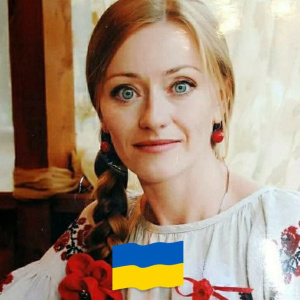
ДОСЛІДЖЕННЯ ТА ПРЕЗЕНТАЦІЯ ФОЛЬКЛОРНИХ ЗРАЗКІВ СЛАВУТЧИНИ УЧАСНИКАМИ КОЛЕКТИВУ «ПЕРЛИНКА»
Майя САЙПЕЛЬ,
керівниця фольклорного колективу «Перлинка»
Будинку дитячої творчості м. Славута (Хмельницька область)
Фольклорний гурт «Перлинка» створено у 1997 році у м. Славута Хмельницької обл. Метою колективу є фіксація, збереження та трансляція пісенних, музичних та словесних фольклорних зразків нашої місцевості, а саме сіл Славутського р-ну Хмельницької області. Тому репертуар “Перлинки” складається з матеріалу, записаного учасниками колективу у фольклористичних експедиціях. Коли у січні 2022 року ми побачили у Фейсбуці допис Руслани Лоцман про початок канадсько-українського проєкту «Збережи мову і культуру своєї бабусі», то безмежно зраділи. Адже на той час ми вже мали власні експедиційні матеріали, у яких записували пісні, обряди, звичаї, традиції, разом з тим, фіксуючи живу мову старожилів (розповіді, діалоги), уважно вслухались в говірку інформантів і потім використовували її в сценічних реконструкціях. У піснях ми теж ніколи не замінювали діалектичні слова на літературні. Тож я одразу запропонувала дітям підготувати кілька відео для проєкту. І нас це дуже захопило. Ми не лише прослуховували старі дослідницькі записи, а й, вирушаючи в нові фольклористичні експедиції, почали звертати більше уваги на діалектичні особливості того чи іншого села, шукати спільність та відмінність у вимові, в окремих звуках, складах тощо.
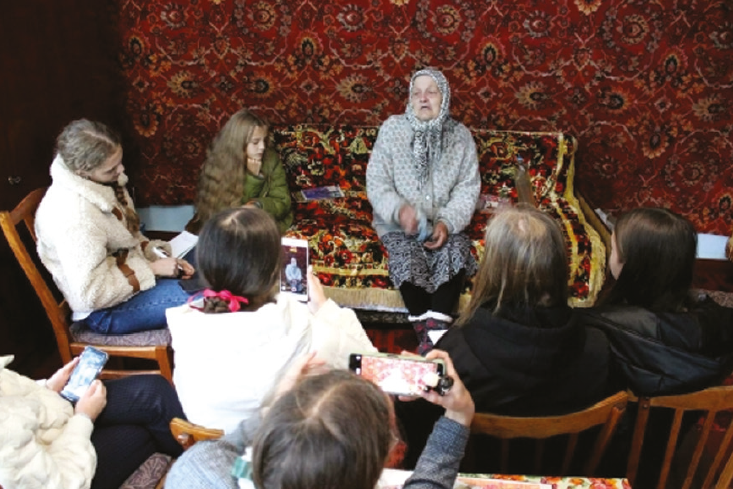
Експедиція в с. Миньківці Славутського р-ну Хмельницької обл. Респондент:
Євгенія Дудар. Слухачі: учасники гурту «Перлинка». Фото Майї Сайпель,
10.10.2023.
Наприклад, в селах, які розташовані поряд, можуть по-різному вимовляти певні слова. Візьмемо для зразку село Сьомаки. Його жителі замість фонеми «о» вимовляють «у». Навіть село Сьомаки вони називають Сюмаки. Приклади: худити, рубити, у двурі, куторий, влужити. У селі Хоровець, що розташоване через ліс від Сьомаків, закінчення іменників у формі множини замінюють з літературного «и» на «і». Приклади: гуркі, рогі, пірогі, стежкі. І практично в усіх селах, які ми досліджували, в іменниках, які починаються на голосні звуки, додають фонеми «г». Приклади: Голя, Ганя, Гандрей, гочи, гонучи, гонук(а), говес. А у селах Шагова, Мухарів «цакають», тобто у закінченнях дієслів замість «ться» говорять «ца». Приклади: прислухаєца, приглядаєца, слухаєца, звеца, нравица. Цікавою особливістю майже усіх сіл дослідженого району є заміна у префіксах «від» на «од». Приклади: одвідати, одказати, одимкнути, одчинити.
У результаті нашої участі у проєкті «Збережи мову і культуру своєї бабусі» учасники «Перлинки» віком від 5 до 18 років презентували 38 робіт (QR код 1). Серед пісенного фольклору в процесі створення відеороликів для проекту нами використано: календарно-обрядові пісні: колядки, щедрівки, веснянки, купальські, жнивні; ліричні пісні; весільні пісні; дитячий фольклор: забавлянки, колискові. Усний фольклор: розповіді про елементи традиційного дівочого строю Славутчини, про святкування щодрухи та обряд водіння Кози, вбірання молодухи до шлюбу, оповідки про зустріч весни, різдвяні вінчування. Пісенні та мовні зразки відтворені з сіл Шагова, Мухарів, Хоровець, Гориця, Сьомаки, Миньківці, Марачівка, Романіни, Хутір Шевченко, Дідова Гора, Пузирки, Марачівка.
Діти переймали фольклорні матеріали двома способами: або з аудіозаписів, або безпосередньо від інформантів. Звісно, другий спосіб вивчення матеріалу ефективніший, адже діти в живому спілкуванні краще сприймають інформацію і можуть точніше передати манеру співу, говірку, певні жести, вони краще засвоюють основи звукоутворення, звуковедення, артикуляцію. Але, на жаль, число респондентів щороку зменшується, оскільки старенькі люди відходять на той світ, тож діти змушені користуватися лише аудіо- або відеозаписами.
Коли в колектив приходять нові діти, я проводжу з ними таку забаву: що означає це слово? Усі діалекти використовую суто з нашого регіону. Дітки іноді висловлюють дуже кумедні припущення. Але, у такий спосіб, вони в ігровій формі дізнаються про нашу рідну говірку. Разом з тим, я пояснюю їм, що діалекти збагачують нашу мову, і ми не маємо стидатися використовувати їх в повсякденному житті, бо в цьому є унікальність нашого регіону та безпосередньо нас, його жителів.
Моя місія та мого колективу - не лише відроджувати нашу пісенну та мовну спадщину, а й транслювати її серед людей, недотичних до фольклорної діяльності, аби українська автентична традиція набувала популярності з кожним днем. Проєкт «Збережи культуру і мову своєї бабусі»- потужний мотиватор у цій надважливій справі.
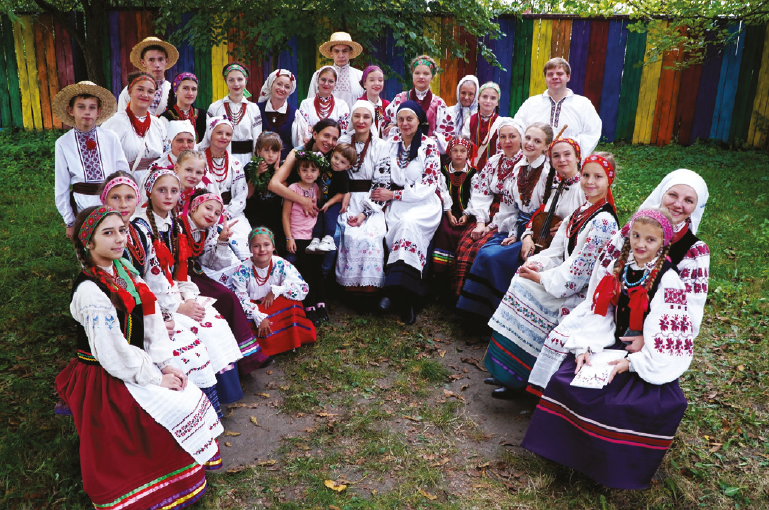
Стоп-кадр з відеоролика про колектив «Перлинка» (керівник Майя Сайпель).

Відеоролик про колектив «Перлинка»
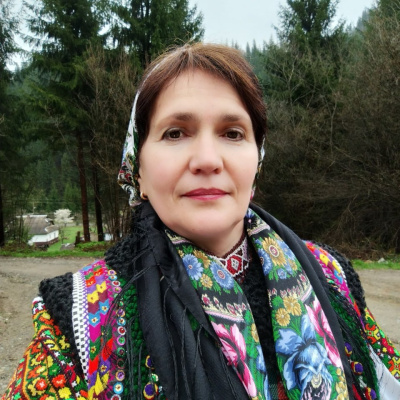
УПРОВАДЖЕННЯ ГУЦУЛЬСЬКОГО ФОЛЬКЛОРУ В ПРОЦЕС НАВЧАННЯ І ВИХОВАННЯ ЛІЦЕЇСТІВ – УЧАСНИКІВ ТЕАТРУ «БАРТКА» с. КРИВОРІВНЯ ІВАНО-ФРАНКІВСЬКОЇ ОБЛАСТІ
Василина ЗЕЛЕНЧУК,
учителька музичного мистецтва Криворівнянського ліцею ім. Михайла Грушевського (Івано-Франківська область)
Гуцульський край є скарбницею, де впродовж століть, незважаючи на різні несприятливі фактори, вдалося і зберегти, і примножити фольклорний посаг (віно). І дуже важливо привити насамперед дітям любов до рідних традицій, музичного та пісенного фольклору свого регіону. На уроках музичного мистецтва, звісно, мусимо дотримуватись навчальної програми. Але дуже раді з того, коли в тій же програмі є 1-2 уроки, присвячені музичній культурі рідного краю. Відразу скажу, що нам цього замало. Вважаю, що на вивчення пісень, співанок, танців рідного краю (відповідно до регіонів) добре би було виділити хоча б третю частину всієї програми. Це суттєво покращило б ситуацію. Учні, вийшовши з стін школи, пішли б у світ з міцним фундаментом знання свого, рідного.
В нашому ліцеї ми з учнями створили гурток «Театр гуцульської співанки «Бартка». Взагалі - наш гуцульський фольклор суттєво відрізняється від інших регіонів. Хто побував на нашій Коляді, чи інших святах, той, звісно, це підтвердить. Наша гуцульська Коляда найкраще збережена в нашому селі Криворівня. Колядують (плєшут (від слова «плєс» – танець чоловіки від Різдва Христового до Водохреща, не минаючи жодної хати. Ми з учнями стараємося зберігати і примножувати надбання наших предків. Співаємо та інсценізуємо співанки, танцюємо гуцульські танці, граємо вистави. До слова, в нас колись, свого часу, жив Гнат Хоткевич. З місцевими гуцулами він організував театр, писав для них п’єси, і гастролював по всій Україні та за її межами. Ми неодноразово відтворювали фрагменти з вистав Гната Хоткевича, де були присутні наші співанки і танці. Жодне свято в нашому ліцеї не обходиться без них. Попри всі складнощі – стараємося тримати своє, використовуючи весь можливий і неможливий час. Найбільша втіха з того, що дітям це подобається. Вони з радістю приходять на репетиції.
Ми беремо участь в найрізноманітніших заходах, конкурсах, концертах. Зокрема, в Харкові (Вертеп-фест), в Івано-Франківську (Університет Короля Данила «Битва вертепів») та конкурс «Серцем єдиним, ми – Україна»), на святкуванні сторіччя Гуцульської республіки у селі Ясіня, що на Закарпатті, тощо. Ставали володарями гран-прі, неодноразово займали призові місця. Нас часто запитують журналісти з різних каналів, мовляв, як довго ми готуємось, наприклад, до Коляди? Іноді буває важко їх (журналістів) переконати в тому, що діти знають тексти
коляд майже з народження. Вони передаються з вуст в уста від своїх батьків, дідусів і бабусь.
Гуцульщина також дуже багата своєю особливою говіркою, музикою, побутом, місцевістю. І, з-поміж усіх регіонів – найкраще зберегла свою самобутність. Працюючи з дітьми у руслі популяризації гуцульських традицій, розуміємо, що саме шкільний рівень – це місце, де потрібно заливати фундамент для культурного розвитку реґіону. Варто більше програмного часу відводити для ознайомлення з регіональними фольклорними особливостями Організація фестивалів, форумів, конференцій є унікальною нагодою поділитися своїм досвідом, перейняти напрацювання інших, а залучення школярів до таких заходів вселяє надію, що народна творчість не загубиться і знайде своє місце у світі сучасних технологій. Віримо, що україноспів дасть широкий розмах крил нашій рідній Україні для щасливого майбуття.
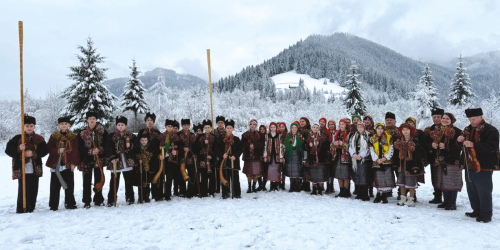
Учасники колективу «Бартка» (керівник – Василина Зеленчук)

Відеоролик колективу «Бартка»
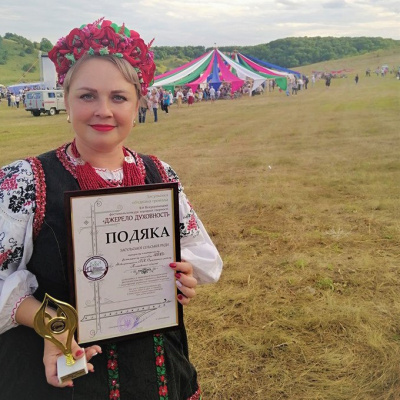
ДОСВІД ЗБИРАННЯ, ВИВЧЕННЯ ТА ПРЕЗЕНТАЦІЇ АВТЕНТИЧНОГО ФОЛЬКЛОРУ ПОЛТАВЩИНИ УЧАСНИКАМИ КОЛЕКТИВУ «КОРАЛІ»
Дар’я АНДРУСЕНКО,
керівниця колективу «Коралі»
с. Новооржицьке (Полтавська область)
Народний аматорський фольклорний гурт «Коралі» займається дослідженням, експедиційними розвідками, вивченням та популяризацією пісенної традиції, звичаїв, обрядів, а також відтворенням звичаїв, традицій, діалектичних особливостей мови та співу Полтавщини. Зокрема, ареалом нашого дослідження є фольклор сіл Лубенського району (Шершнівка, Назарівка, Тарасівка, Солониця, Тернавщина, Ісківці, Воронинці, Остапівка, Хорошки), Миргородського району (Клюшниківка, Рашівка, Веприк), Пирятинського району (Крячківка, Олександрівка). Впродовж діяльності колективу «Коралі» були дуже цікаві експедиції – групові записи та індивідуальні зустрічі з носіями автеничного фольклору. Це дозволило записати розповіді про традиційні обряди полтавського краю: дівич – вечір, весілля, сватання, хрестини, щедрування та поховання, весняні гуляння на колоді, розповіді про гадання на Андрія, про буденне життя (де в якій хаті збиралися шити, вишивати), про обрядові страви, які готували кожного дня і на свята, про історію села, небилиці та оповідки, казки. Найбільше записано весільної обрядовості, родинно-побутових пісень, цілий цикл Різдвяний (щедрівки та колядки).
Колектив «Коралі» складається з учасників віком від 7 до 78 років, кількісний склад налічує 24 особи. На виїзні концерти, фестивалі їздить переважно молодь 13 – 19 років у супроводі керівника. Репертуар «Коралів» - весільні пісні, веснянки, петрівчані, купальські, жнивні, родинно-побутові, щедрівки, колядки, строкові, солдатські, козацькі, чумацькі пісні. В усіх виступах колективу ми презентуємо програму на автентичному матеріалі. Наприклад, відтворення обряду «Вбирання молодої» супроводжують пісні, які записували в експедиціях. Також сценічним одягом колективу є автентичне вбрання Полтавщини.
У виконанні колективу фольклор Полтавщини звучить під час фестивалів та конкурсів, що відбуваються в різних областях України. Так, у січні 2025р. гурт «Коралі» представляв Полтавщину у Львові в Домініканському соборі на фестивалі «Велика коляда», де звучали автентичні щедрівки та колядки нашого краю. Ми є учасниками обрядового дійства «Українське весілля» на Національному сорочинському ярмарку, Всеукраїнських фестивалів «Ярмариночка» (2015 – 2024рр.), презентації національного Сорочинського ярмарку у м. Львові, обрядового дійства «Наддніпрянське весілля» (2018-2019 рр.). «Коралі» є переможцями Всеукраїнського фестивалю – конкурсу «Джерело духовності», Всеукраїнського сільського фестивалю народної творчості «Катеринина пісня». Неодноразово презентували фольклор Полтавщини на всеукраїнських та міжнародних фестивалях: «Переяславський ярмарок», «Коляда на Майзлях», «Зелені свята», «Осінь весільна», «Україна єднає світ» та ін.
Упродовж 2022-2025рр. «Коралі» долучилися до реалізації канадсько-української програми «Збережи мову і культуру своєї бабусі», ставши одним з семи опорних фольклорних колективів, що вивчають та відтворюють автентичну пісенну традицію і місцеву говірку рідного краю. Солістами колективу підготовлено відеоролики з демонстрацією мовно-музичного діалекту Полтавщини, що можна переглянути на сайті програми.
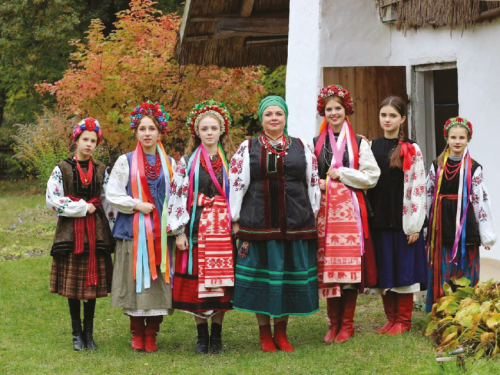
Фольклорний колектив «Коралі» (керівник Д. Андрусенко)

Відеоролик про колектив «Коралі»

ВИВЧЕННЯ АВТЕНТИЧНОГО СЛОБОЖАНСЬКОГО ФОЛЬКЛОРУ ВИХОВАНЦЯМИ КОЛЕКТИВУ «ВЕРБИЧЕНЬКА» м. НОВА ВОДОЛАГА ХАРКІВСЬКОЇ ОБЛАСТІ
Ольга і Тетяна КОВАЛЬ,
керівники народного дитячого фольклорно-етнографічного колективу «Вербиченька»
м. Нова Водолага (Харківська область).
Понад тридцять років колектив «Вербиченька» здійснює фольклорні експедиції Слобожанщиною. Головним критерієм у напрямку пошуково-дослідницької діяльності є безпосередній зв’язок із носіями традиційної етнокультури. Пошуково-дослідницька діяльність є однією з важливих і необхідних форм роботи. Досліджено Західну, Центральну та Південну Слобожанщину. Обстежено також Зачепилівський район – історичну частину Полтавщини, який нині входить до складу Харківської області. Безпосередній контакт із носіями народної традиції сприяє вивченню та збереженню рідної мови через призму життя та побуту, народних звичаїв, обрядів, пісенної спадщини українських селян. Вік респондентів, які несли інформацію, досить поважний. Можливо, вже життя декого з них клубочком покотилося з «цього світу» в інші світи. Розповідаючи про минувшину, майже всі говорили, що чули це від своєї бабусі чи прабабусі, або від старезного діда, який ще до війни приходив у село. Враховуючи це, молодим дослідникам, треба поспішати, щоб зібрати і зберегти джерело народних знань, унікальні скарби народної культури і багатогранної мови наших предків, залишити їх у спадок майбутнім поколінням.
Відомо, що слобожанський діалект сформувався у ХVІ–ХVІІ ст., коли так зване Дике поле заселяли люди з різних українських земель: Полтавщини, Чернігівщини, Поділля. У цей час відбувалося заселення і з московії, що значно вплинуло на виникнення суржику. Вихованцям колективу «Вербиченька» у 2000-х роках доводилося брати участь у фольклорних фестивалях у Воронезькій та Курській областях. Ми стали свідками широкого розповсюдження і розуміння української мови серед населення. Це свідчить про історичну територію Слобідської України з її слобожанською говіркою. У слобожанських селах доволі часто спостерігаються русизми, якими заміняють українські слова. Так внаслідок примусової русифікації в українській розмовній мові виник суржик. Від респондентів почули такі «сковеркані» слова: «каждий», «даже», «навсігда», «отвічати», «спішити», «чуствувати», «хвате», «нільзя, ніззя», «нада», «січас», «вобще», «раньше», «времня», «помню», «обіда» (образа) і т. ін. Звісно, суржик збіднює українську говірку, а діалектизми живлять її та збагачують.
Українська мова краще збереглася у сільській місцевості Слобожанщини. Саме в селах звучить жива повсякденна мова зі своїми регіональними особливостями та діалектизмами, що робить наше мовлення багатшим і різноманітнішим. Усе розмаїття розмовної мови у респондентів висвітлює типові сторони побутового життя селян, які також можуть бути мало зрозумілими нашому молодому сучаснику. Але мова звучить, з притаманним їй колоритом старовини, адже ще декілька століть все те було загальноприйнятою нормою життя селян нашого краю. Як приклад: «діжа», «заслінка», «біжниці», «лампадка», «каганець», «стьожки», «казанок», «ступа», «долівка», «сволок», «призьба», «мотузка», «сіни», «комора», «вервечки» тощо. Наявність маловживаних, незрозумілих для сучасної молоді слів вказує на їхню давність і приналежність до української традиції. Досить часто ці слова відображають назви предметів домашнього побуту або приналежність людини до тієї чи іншої справи. Як приклад, подаємо слова, що називають ремесло прядіння і ткацтва: «коноплі», «костриця», «прядка», «веретено», «веретільник», «ткаля», «бительня», «снівниця», «терниця», «мички», «витушка», «жлукто» та ін.
Слобожанській говірці притаманне шокання. Літературне «що» не промовляв жоден інформант, з яким довелося спілкуватися. Завжди звучало: «шо», «нашо», «ішше», «шото», «якшо». Яскравий приклад: «А ти кажеш, шо я там шо чи абишо! Нехай міні бознашо, коли збрехав шо, про шо, або нашо» (смт. Нова Водолага, Харківщина). Поширені у слобідських говірках пом’якшення в кінці слова: «базарь», «пахарь»; замість літературних слів «витопить», «робить», «ходжу» трапляються «витопе», «робе, ізробе», «ходю»; особливі форми пом’якшення приголосних: «збірали», «простілали», «штані» (наголос на перший склад), «колодізь», «бандіти», «зіма», «біз» (замість «без»), «двадьцять», «єсьть», «зьвізди», «кьвіточки»; вживання вставного звуку «н»: «мнясо», «маненький», «сімня»; заміна звука «ф» на «хв»: «Хведько», «канхвети», «хвартух»; додавання звуків на початку слів для зручності їх промовляння: «вікони», «вумниця», «юлиця» і навпаки – відсутність першого звуку у словах: «орішки», «одлітати»; заміна звуків: «кісто», «хитиці», «здоровля», «свальба», «колбаса»; пом’якшена вимова приголосного «ч»: «чясто», «чявун», «луччє» та їн.
На Сумщині зустрічається пом’якшення звуку «л» (Охтирський, Лебединський райони): «льовко». Таку ж вимову чули від респондентів у деяких селах Харківщини, що межують з Полтавщиною (Зачепилівський район). До слобожанських діалектів належать словоутворення, що збагачують живу мову, додають їй самобутності: «сперва» (спочатку), «багацько» (багато), «уп’єть, уп’ять» (знову), «тіки» (тільки), «ніраз» (жодного разу); незвичайні слова, які захоплюють слухача новоутвореннями: «покотьоли» (сонячні розводи на небі), «мататон» (томада на весіллі), «сконплижити, спаплюжити» (зіпсувати), «белькотіти» (говорити), «примхи» (забобони), «плентається» (повільно іде), «триндикати» (говорити нісенітниці). Звідси: «Тринди-ринди, з маком борщ», «Триндикали, поки хлопців накликали» (с. Завадівка, Харківщина). Цікавим явищем у розмовній мові слобожан є тюкання. Вигук «тю-ю-ю!» зупиняє того, хто верзе дурниці, говорить нісенітниці, або робить дію, несумісну з правилами поведінки. Слобожанська жива говірка має досить цікаві словосполучення, що ілюструють мовні особливості краю: «насилу втекла», «покотом полягали», «гульк у вікно», «юшку варити», «зробилася тривога», «земель п’ять десятин», «вузлик напам’ять», «байдики бити», «на кудикину гору», «за мною ув’язалася», «дощ як учисте» та ін.
У проєкті представлені перекази, легенди, казки, створені на основі місцевого матеріалу і передані у спадок від селян-слобожан. Історичні факти і важливі деталі несуть оповідки про Парасковіївську кріпость, про турків і козаків, про церкву та ікону Святої П’ятінки (с. Парасковія, Харківщина), про магічну гору Курган (с. Курган, Сумщина), про урочище «Образ» (с. Малий Бобрик, Сумщина). Неперервність життя, наступність поколінь підкреслюється тією провідною роллю, яка належить, з одного боку, старшому поколінню, збагаченому досвідом, життєвою мудрістю, а з іншого – молодому поколінню, яке уособлює місію продовження роду, його культури і мови. В оповідках слобожанами передано багатогранність народних звичаїв і традицій календарно обрядового циклу, які насичені локальними діалектами, яскравою говіркою та виражають найбільш стійку етнічну традицію: Різдвяні святки, Великдень, Трійця, Купала, Спиридона Сонцеворота. Родинні та сімейно-побутові традиції представлені яскравими весільними обрядодіями, а народні гуляння на колодках та вечорницях насичені розмаїттям слобожанської говірки.
«Народ скаже, як зав’яже», – ця загальновідома мудрість підкреслює неперевершене значення прислів’їв, приказок, а також фразеологізмів, якими так збагачена жива розмовна мова слобожан. Саме ця вагома частина фольклорної спадщини відбиває світогляд українського народу. З покоління в покоління передаються ці шедеври усної народної творчості як невід’ємна складова нашої мови, що надає їй барвистості й виразності. Це багатство українського народу. Для всіх, хто цікавиться історико-культурною спадщиною, традиціями та звичаями, історичним краєзнавством Слобідської України, особливо важливим і необхідним став канадсько-український проєкт Премія Granny «Збережи мову і культуру своєї бабусі» (2022 – 2024 рр.). До нього долучились вихованці народного художнього фольклорно-етнографічного колективу «Вербиченька» Нововодолазького будинку дитячої та юнацької творчості Нововодолазької селищної ради Харківської області. Ми упевнені, що від збереження мови і культури своїх предків залежить майбутнє українців і України як держави. Саме це переконання дало поштовх до участі у проєкті.
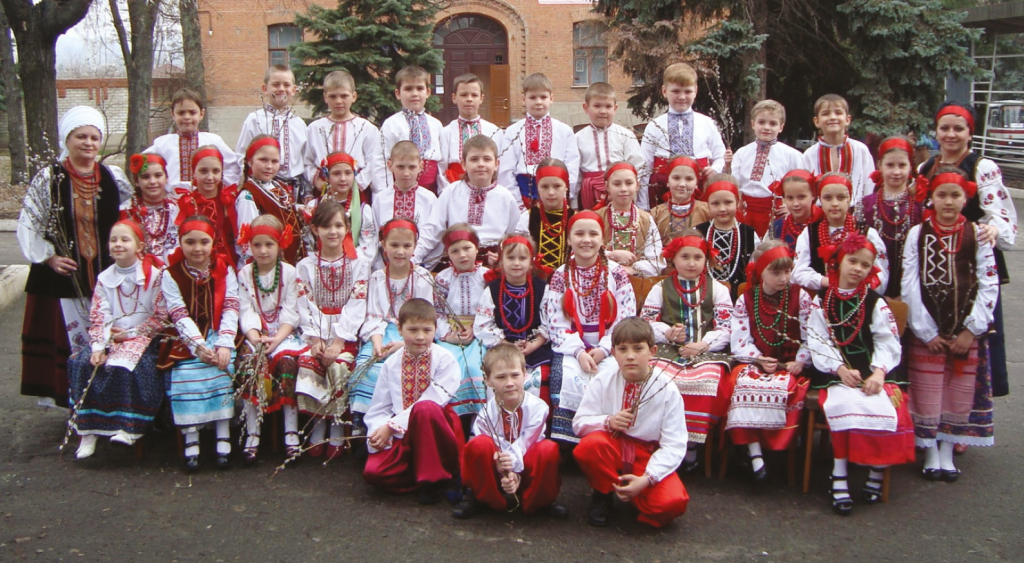
На фото: колектив «Вербиченька» (керівники – Ольга та Тетяна Коваль).
Ось деякі фольклорних матеріалів, перейняті юними дослідниками «Вербиченьки» від респондентів Слобожанщини та представлені у проєкті: «За царя Панька, як земля була тонка»; «Хто примічає. той і отвічає»; «Серце наче в п’ятках стукотить»; «Руки не терплять, вишивати хотять»; «Кишки у пузі марш грають»; «За цяря горошка, коли людей було трошки»; «Причепився, як отой ріп’ях»; «З-під сміху люди бувають»; «Намолов на осиці кислиці, а на вербі – груші»; «Тіки-навтіки, вже минули празники»; «В тісноті – не в обіді».
Як бачимо, знання історичних, етнографічних культурних і духовних надбань необхідні для використання кращих національних традицій у сьогоденні. Пріоритетом навчально-виховного процесу нашого колективу завжди було і залишається виховання цілісного ставлення особистості до культурної спадщини українського народу, формування у молодого покоління почуття любові до Батьківщини, до рідної мови, поваги до народних звичаїв, традицій, духовних цінностей. До всього, що передається з покоління в покоління, як загальноприйняте, загальнообов’язкове, перевірене досвідом, визначене необхідним для забезпечення подальшого існування української етнотрадиції.
На основі експедиційних матеріалів колективу презентовано наступні видання: «Слобожанські казки» (47 слобідських казок), інформаційно-методичні матеріали «Краєзнавчі шляхи Слобожанщини» (матеріали пошуково-краєзнавчої роботи вихованців «Вербиченьки»), книга «Вбрання українців Слобожанщини ХХ століття» (огляд традиційного вбрання колекції «Вербиченьки»), аудіоальбом «Ой, поля, ви поля» (2016) та ін. (1-4).
Список використаних джерел:
1. Казки Слобожанщини, зібрані під час експедицій народного художнього фольклорно-етнографічного колективу «Вербиченька» Будинку дитячої та юнацької творчості смт. Нова Водолага Харківської області / Записувачі, автори статті О. Коваль, Т. Коваль. Передмова, упоряд. та коментарі В. Сушка. Харків : Вид-во Бровін О. В., 2010. 64 с.
2. Коваль О. В., Коваль Т. П. Вбрання українців Слобожанщини ХХ століття: за матеріалами народного художнього фольклорнотнографічного колективу «Вербиченька» Нововодолазького будинку дитячої та юнацької творчості / за заг. редакцією В. А. Сушко. Харків : Тім Пабліш Груп, 2017. 100 с.; іл.
3. Коваль О. В. Нововодолазькі голосники - 2 : фольклор., етногр., іст.-краєз. розвідки нар. худож. фольклор.-етногр. колективу «Вербиченька» Нововодолазького БДЮТ / О. В. Коваль, Т. П. Коваль. Харків : Бровін О. В., 2011. 278с.
4. Коваль О.В., Коваль Т.П. Нововодолазькі голосники: Фольклорні, етнографічні, краєзнавчі розвідки зразкового художнього фольклорно етнографічного колективу «Вербиченька» / Переднє слово В. Сушко. Харків : ПП Якубенко, 2007. 224 с.

Відеоролик про колектив «Вербиченька»
